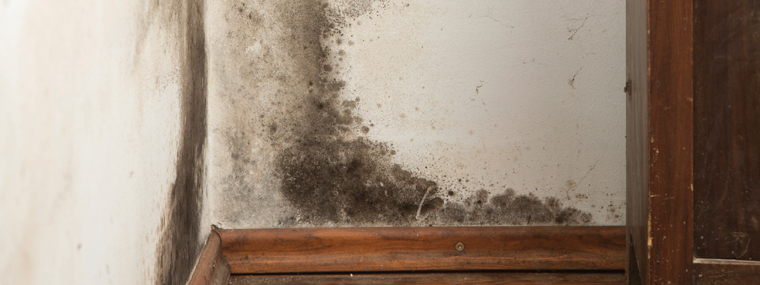
Mold Awareness
Moisture Control is Key
by Heather J. Roembke / Published December 2015

The problems with mold have become so significant that September was declared National Indoor Mold Awareness Month by the U.S. Environmental Protection Agency (EPA). There are approximately 1,000 species of mold that can be found in the United States, with more than 100,000 known species worldwide. As long as moisture and oxygen are present, mold can grow indoors or outdoors on virtually any organic substance, including wood, paper, carpet, insulation, and food. Left untreated, mold gradually destroys the material on which it is growing. More importantly, mold releases chemicals that can cause strong allergic reactions in humans—making them feel sick—sometimes dangerously so.
Warm and humid weather provide excellent conditions for mold to grow if a builder has constructed a house or condominium without taking appropriate steps to prevent rain from getting inside the house or condominium. The major causes of mold problems in Florida include, but are not limited to, high humidity, leaky roofs, plumbing leaks, internal air-conditioning leaks, and ground water wicking up through concrete floors. As we enter the fall, it is important to ensure your home can stand up to moisture intrusion that can lead to mold problems.
Moisture control is key—mold cannot grow without it. To assist in controlling moisture, try to keep the humidity in your home under control. The ideal humidity for a home should measure between 30 and 60 percent. Additionally, you can control moisture by using an air conditioner and/or dehumidifier in damp spaces during humid months and utilize exhaust fans in the bathroom and kitchen.
Another situation homeowners often face are leaks in the home (ceiling, roof, plumbing, etc.) The first sign of mold, due to leaks, may be musty odors in the vicinity of the leak. Do not sniff for mold or touch mold. According to the EPA, the only way to prevent mold growth is to find and correct water damage and leaks. Clean and dry any damp or wet building materials and furnishings within 24–48 hours. Additionally, check for leaky roofs, foundations, faucets and pipes, ensuring these areas are not accumulating extra moisture.
A question often asked by homeowners is, will mold make me sick? According to The Journal of the American Medical Association (JAMA) and the Centers for Disease Control and Prevention (CDC), mold growth in water-damaged homes and office buildings can create a potential health hazard for individuals sensitive to mold. While most molds pose no threat to humans, the CDC warns that certain molds can produce hay fever-like allergic symptoms (such as eye irritation, skin rash, and nasal congestion). The presence of mold can also exacerbate existing conditions, such as asthma. However, not all molds cause these reactions and not all people are allergic to molds.
If you believe you are ill because of exposure to mold, you should first consult your health care provider to determine the appropriate action to take to protect your health. Your next step should be to consult with a construction professional to determine the source of the water. If your home is less than 10 years old, you may also want to consider consulting with an attorney with experience handling construction defects to determine if the builder is responsible for correcting the source of water in your home.
Interesting facts about mold:
- Mold can start to grow in as little as 48 hours, therefore, it is important to act fast to help prevent mold from growing and spreading.
- One common antibiotic is actually a purified mold—penicillium notatum, or penicillin.
- Your homeowner insurance may specifically exclude coverage for damage directly related to mold.
- Mold destroys more wood each year than all the fires, floods, and termites combined.
- Mildew is mold…many people think they are two very different things, but they are not.
- Mold does not need light to grow, which is why it is common to find mold in the dark, poorly lit areas of the home.
- Mold spores, whether dead or alive, can cause adverse health effects.
- Mold can be many colors including black, white, blue, green, yellow, and pink.
What should you do if you suspect mold is a problem in your home? If mold is a problem in your home, the mold must be cleaned up and the source of the water isolated and repaired. Likely, this will require consultation with an experienced construction professional.
You can wash mold off hard surfaces with bleach and water. However, mold on soft surfaces, such as wallboard, curtains, furniture cushions, clothing, and carpeting must be professionally treated or, in many cases, must be removed and destroyed. You should contact a certified mold inspector if you suspect mold. Remediation professionals are specifically trained to isolate and treat mold-affected areas in ways that avoid contaminating the entire living space.
For more information on how to clean up residential mold problems and how to prevent mold growth, download the Environmental Protection Agency’s free publication, A Brief Guide to Mold, Moisture, and Your Home at www.epa.gov/mold/pdfs/moldguide.pdf. You can get more information on mold by accessing the Centers for Disease Control at www.cdc.gov. Also, the Florida Department of Health Indoor Air Program helps with mold issues by providing technical assistance and advice to the public, county health departments, school districts, and others and distributing current information and other resources on mold and moisture control. The Florida Department of Health does not provide mold testing services.
Disclaimer: This article is for informational purposes only. It is not intended to diagnose, treat, cure, or prevent any mold-related disease or take the place of medical advice and treatment from your personal physician, nor is it intended to serve as legal counsel.
Heather J. Roembke
Angius & Terry
Heather J. Roembke is an attorney in the Sarasota, Florida office of Angius & Terry LLP. Her primary focus is representing community associations and homeowners in construction defect litigation. Roembke obtained her Bachelor of Science and Master’s Degree from East Carolina University. She attended law school at Barry University School of Law in Orlando where she served on the nationally-ranked trial team and interned under the Honorable Anthony Johnson. Roembke is admitted to practice in all Florida State Courts and has been a member of the Florida Bar since 2007. For more information, e-mail hroembke@angius-terry.com or visit www.angius-terry.com


